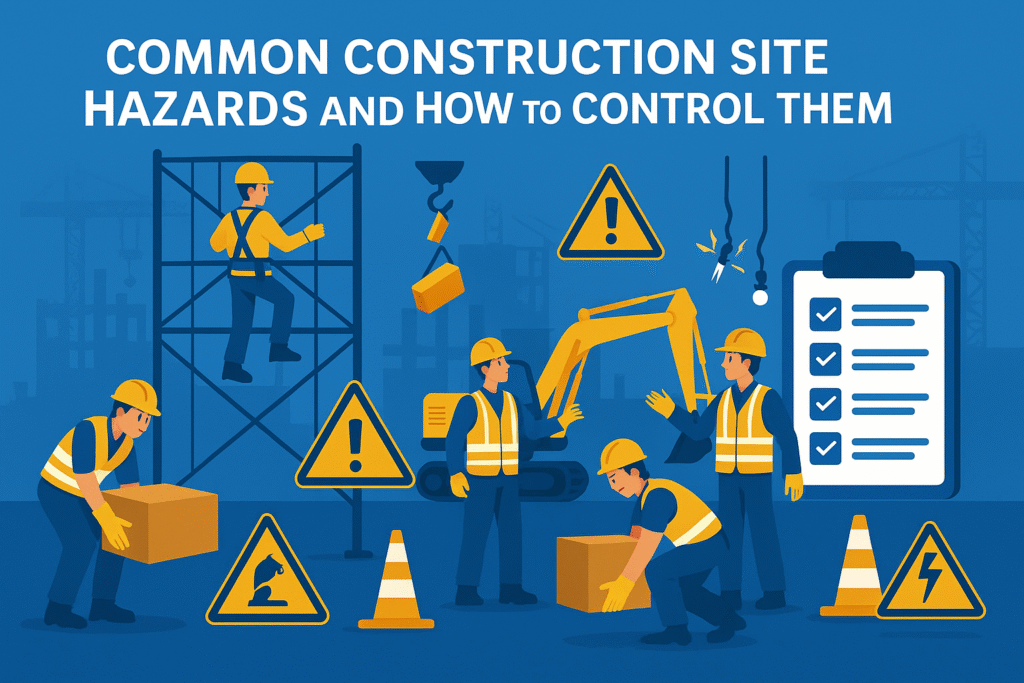
Common Construction Site Hazards and How to Control Them
Construction sites are among the most dangerous workplaces in the world. Every year, thousands of workers are injured due to falls, struck-by incidents, electrical hazards, and more. The good news? Most of these accidents are preventable when hazards are identified early and proper controls are implemented.
In this article, we will cover the most common construction site hazards and the control measures needed to protect workers and maintain a compliant, safe work environment.
Why Construction Sites Are High-Risk
Construction involves heavy machinery, high elevations, electrical systems, chemical substances, and constant movement of people and equipment. This combination creates an environment where hazards can quickly turn into serious accidents unless properly managed.
A proactive approach to hazard identification and control is essential to preventing injuries and fatalities.
Common Construction Site Hazards and How to Control Them
Below are the major hazards found on construction sites along with practical and effective control measures.
1. Working at Height
One of the leading causes of fatalities in construction.
Examples:
- Roofing work
- Scaffold tasks
- Ladder use
- Working on open edges
Control Measures:
- Use guardrails and toe boards on elevated platforms
- Provide fall arrest systems (harness, lanyard, lifeline)
- Inspect scaffolds and ladders daily
- Use only trained and authorized workers
- Keep surfaces clean and free from trip hazards
2. Falling Objects (Struck-By Hazards)
Tools, materials, or debris falling from heights pose a significant danger.
Control Measures:
- Use tool lanyards to secure tools
- Install debris nets and toe boards
- Enforce hard-hat area requirements
- Barricade work zones below overhead activities
- Store materials safely and away from edges
3. Electrical Hazards
High-voltage equipment and temporary wiring systems increase the risk of electrocution.
Common sources:
- Exposed wires
- Damaged cords
- Unprotected circuits
- Overhead power lines
Control Measures:
- Implement Lockout/Tagout (LOTO) procedures
- Use only certified electricians for electrical tasks
- Inspect cables, power tools, and extension cords regularly
- Maintain clearance from overhead power lines
- Install Ground Fault Circuit Interrupters (GFCIs)
4. Slips, Trips, and Falls
These hazards occur due to poor housekeeping, uneven surfaces, or clutter.
Control Measures:
- Keep pathways clear of materials
- Mark uneven surfaces and transitions
- Use anti-slip mats in wet areas
- Provide proper site lighting
- Follow housekeeping standards (daily cleaning)
5. Heavy Equipment and Machinery Hazards
Cranes, excavators, forklifts, and loaders can cause severe injuries when improperly used.
Control Measures:
- Operators must be trained and licensed
- Provide equipment inspections before every shift
- Maintain exclusion zones around machinery
- Use spotters for blind spots
- Install reverse alarms and flashing beacons
6. Excavation and Trenching Hazards
Cave-ins are among the deadliest construction hazards.
Control Measures:
- Use shoring, shielding, or benching systems
- Keep heavy equipment away from trench edges
- Test atmosphere for toxic gases
- Provide safe access (ladders every 25 ft)
- Inspect trenches daily and after rain
7. Noise Hazards
Prolonged exposure to high noise levels causes hearing loss.
Control Measures:
- Conduct noise level assessments
- Provide hearing protection (earplugs, earmuffs)
- Isolate noisy equipment
- Limit exposure time and rotate workers
8. Manual Handling and Ergonomic Hazards
Improper lifting or repetitive work causes musculoskeletal injuries.
Control Measures:
- Train workers on correct lifting techniques
- Use mechanical lifting aids (hoists, trolleys)
- Break heavy loads into smaller units
- Rotate tasks to reduce repetitive strain
9. Hazardous Substances (Chemical Hazards)
Construction workers may be exposed to solvents, adhesives, paints, and dust.
Control Measures:
- Use proper ventilation systems
- Provide and enforce PPE use (gloves, masks)
- Store chemicals safely and label clearly
- Use Safety Data Sheets (SDS)
- Implement dust suppression measures
10. Fire Hazards and Hot Work
Welding, cutting, grinding, and flammable materials increase fire risk.
Control Measures:
- Implement a Hot Work Permit system
- Keep fire extinguishers nearby
- Remove combustible materials before hot work
- Provide fire-resistant clothing
- Train workers in fire emergency procedures
11. Confined Space Hazards
Areas like tanks, manholes, and tunnels have limited ventilation.
Control Measures:
- Conduct atmospheric testing
- Use Confined Space Permit systems
- Provide proper ventilation and lighting
- Assign trained attendants and rescue teams
- Use gas detectors continuously
12. Weather-Related Hazards
Heat stress, cold exposure, rain, and strong winds affect construction workers.
Control Measures:
- Provide hydration and rest breaks
- Issue weather-appropriate PPE
- Stop work during storms or high winds
- Monitor weather forecasts daily
How to Build a Safer Construction Site
A safe site requires a systematic approach:
- Conduct daily toolbox talks
- Carry out regular risk assessments
- Enforce PPE compliance
- Provide continuous training
- Maintain proper housekeeping
- Encourage hazard and near-miss reporting
When everyone takes responsibility, hazards are easier to control and accidents become preventable.
Conclusion
Construction sites are dynamic and full of potential hazards, but with proper controls, training, and awareness, accidents can be significantly reduced. Identifying hazards early and applying the correct safety measures protects workers, saves time, and ensures compliance.
Remember: A safe site is a productive site.
For checklist and templates visit The HSE Tools.
The Role of Safety Committees in Workplace Safety
How to Conduct a Basic Safety Induction for New Employees
Understanding Near Miss Reporting and Its Importance
Difference Between Hazard and Risk Explained
How to Build a Positive Safety Culture in the Workplace
Frequently Asked Questions (FAQs)
What are the most common hazards on a construction site?
Falls, electrical hazards, heavy machinery, chemical exposure, and struck-by hazards.
How do you control construction hazards?
Through engineering controls, administrative measures, PPE, training, and proper planning.
Who is responsible for construction site safety?
Everyone — site supervisors, workers, safety officers, and management.
Why is hazard identification important in construction?
It prevents accidents, saves lives, and helps meet legal requirements.
How often should safety training be conducted?
Regularly — including inductions, toolbox talks, and refresher training sessions.